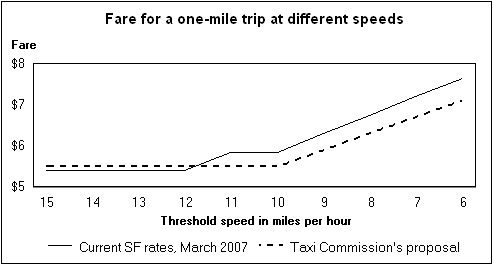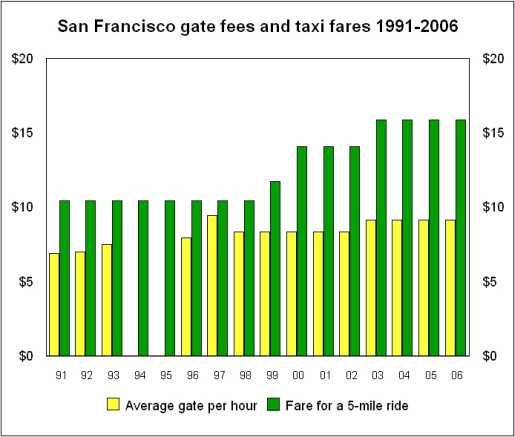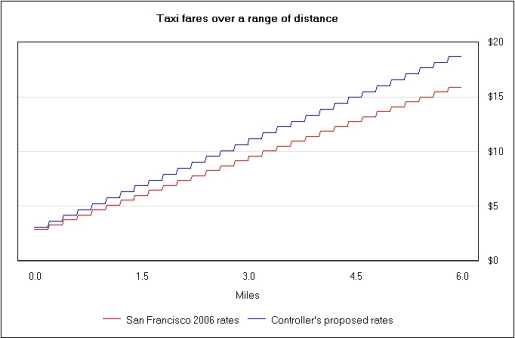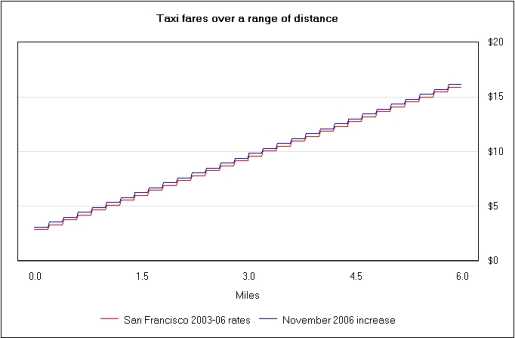Ill-considered rate proposals
Two recent rate proposals would inadvertantly lower the speed at which the meter switches from charging for distance to charging for time. Too low a changeover speed is undesireable because it gives drivers an incentive to shun downtown areas where traffic is often slow.
The changeover speed in San Francisco is 12 mph. The speed is determined by a simple relationship: the charge per hour divided by the charge per mile. The current rates are $27.00 per hour or $2.25 per mile. (27 divided by 2.25 equals 12)
A proposed change by the Taxi Commission (intended to fund health care) would change several elements of the fare structure: the initial charge (from $3.10 to $3.00), the additional mileage charge and per-minute waiting time charge (from $0.45 to $0.40), and the increment of distance used by the meter in calculating the fare (from 1/5 mile to 1/6 mile). The new rate would yield $24.00 per hour for waiting time or $2.40 per mile for distance. In this case, the formula for computing the changeover speed yields 10 mph. (24 divided by 2.40 equals 10)
In addition to reducing the changeover speed, the Commission's proposed rate "increase" inadvetantly reduces the charge for waiting time by three dollars per hour, from $27 to $24. So when time charges finally do begin, at speeds below 10 mph, the rate would be lower than the current rates of fare.
 The Taxi Commission's proposed rate increase would yield an absolutely lower fare at speeds under 12 miles per hour compared to the current rate of fare. At low speeds, the charge is for time only, and not for distance. In this case, the reduced time charges causes a lower fare in addition to a lower speed for the changeover to time charges.
The Taxi Commission's proposed rate increase would yield an absolutely lower fare at speeds under 12 miles per hour compared to the current rate of fare. At low speeds, the charge is for time only, and not for distance. In this case, the reduced time charges causes a lower fare in addition to a lower speed for the changeover to time charges.
Another proposal, presented by the Controller to adjust driver incomes along with an increase in the number of cabs, would make just one change to the rate of fare: add five cents to the additional mileage charge, raising it from $0.45 to $0.50 per 1/5 mile. The proposed rate would leave the waiting time charge at the current $0.45 per minute. The rate would parse out to $27.00 an hour for waiting time or $2.50 per mile for distance, and a changeover speed of 10.8 miles per hour.
The Controller's rate formula is problematic for a second reason, which makes it impossible to program into a taximeter: a meter cannot register different charges for units of distance and time. The increment of distance or time can be changed, i.e. more or fewer seconds, or longer/shorter distance, but once the units have been set, the charge for each meter "tick" of distance or time must be the same. The technically inclined may wish to read the discussion of proportional rates in taximeters at the website of the National Institute for Standards and Technology.
If charted, the Controller's proposal would show that the nominal fare increase would be a wash for drivers when traffic is slow. At low speeds, the fare would be the same or almost the same as with the current rates of fare, except that the changeover to time charges would be at a slower speed. Drivers would soon sense that driving in traffic had become relatively less profitable, and would perceive an incentive to avoid trips that take them into areas that are prone to traffic delay.
The lesson for policy makers is to look carefully at any proposed rate change, especially if the units of distance or time are being changed, or if a change in charge is proposed for distance but not for time. The inadvertant result could be a rate formula that runs counter to the interests of the public and drivers alike.
Current San Francisco taxicab rate of fare
- Initial 1/5 mile or 1 minute of waiting time: $3.10
- Additional 1/5 mile or 1 minute of waiting time: $0.45
- Surcharge on trips originating at SF International Airport: $2.00
- Long trip surcharge: 50% of the metered fare for trips that go more than 15 miles beyond the city limits, or beyond SFO if the trip begins there. There is no long-trip surcharge to SFO or to Oakland Airport.
- Bridge tolls (paid by the passenger) are $4 for trips that cross the Bay Bridge and $5 for for trips that cross the Golden Gate Bridge.
Gates and Fares 1991-2006
| Year | 10-hour gate | 5-mile fare |
|---|---|---|
| 1991 | $69.10 | $10.45 |
| 1992 | $70.30 | $10.45 |
| 1993 | $74.90 | $10.45 |
| 1994 | n.a. | $10.45 |
| 1995 | n.a. | $10.45 |
| 1996 | $79.60 | $10.45 |
| 1997 | $94.60 | $10.45 |
| 1998 | $83.50 | $10.45 |
| 1999 | $83.50 | $11.75 |
| 2000 | $83.50 | $14.10 |
| 2001 | $83.50 | $14.10 |
| 2002 | $83.50 | $14.10 |
| 2003 | $91.50 | $15.90 |
| 2004 | $91.50 | $15.90 |
| 2005 | $91.50 | $15.90 |
| 2006 | $91.50 | $15.90 |
The chart below uses the table data to illustrate the rise in gate and meter rates since 1991 by comparing the hourly gate (in yellow) with a sample 5-mile fare (in green). The increase in gates was 32.4% while the increase in the sample fare was 52.2%. During the same period, the CPI rose 49.7%.

Data sources: The sample fares are from the SF Controller's Taxicab Industry Report for 2006. Hourly gates for 1998-2004 are the Controller's figures divided by ten hours. 1991-97 gates are averages for Yellow, Luxor, DeSoto and Veterans from the SF Taxicab Association. 2005-06 gates are the current averages.
The November 1 rate increase displayed in charts
The August 1, 2006 Taxicab Industry Report (302kb PDF) from the San Francisco Controller made recommendations for changes to rates of fare. The rate of fare in effect since 2003 was $2.85 for the first 1/5 mile, and $0.45 per additional 1/5 mile or minute of waiting time. The proposed increase would have added $0.23 to the initial or flag amount, and $0.09 to each 1/5 mile "tick" for additional distance. This chart compares the 2006 rates (in effect since 2003) with the Controller's proposed increase, which was based on CPI, fuel costs and the costs of paratransit service.
 The proposed increase over a range of 0 - 6 miles.
The proposed increase over a range of 0 - 6 miles.
The Board of Supervisors decided instead to raise meter rates by $0.25 per trip added to the flag with no increase to the mileage component of the fare. The new rate of fare is thus $3.10 for the first 1/5 mile, and $0.45 for each additional 1/5 mile or minute of waiting time. The next chart illustrates that actual rate increase which went into effect on November 1, 2006. It is clear from the two charts that the mileage increase, not the flag increase, was by far the most significant component of the proposed meter increase.
 The 25-cent increase over a range of 0 - 6 miles.
The 25-cent increase over a range of 0 - 6 miles.
If the Taxi Commission presents the Supervisors with a driver health care plan in April 2007, there will be a another review of fares at that time.
[ Back to top ]
Your business moves fast...keep up by joining MHA today